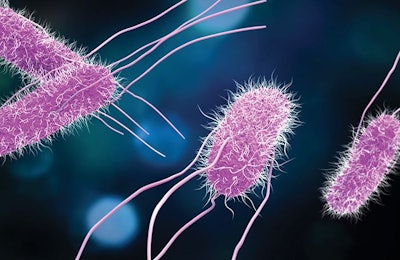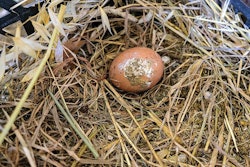
Salmonella is widely distributed in poultry and in their environment meaning that any control program must consider a number of factors to protect birds from colonization.
An integrated approach focusing on feed and farm and health management can protect birds from Salmonella colonization and invasion, lower Salmonella pressure in processing and support farmers’ feed-to-food safety efforts.
While there may be no silver bullet in Salmonella control, protocols and accurate medication programs can all contribute to a lower Salmonella prevalence pre harvest, with feed mill and farm practices key to reducing pressure on broiler farms.
Feed and feed mill hygiene
Monitoring programs have detected a variety of Salmonella serotypes in breeder, layer and broiler feed. These serotypes can often be traced back to Salmonella-contaminated feed materials, such as animal- and vegetable-derived proteins. Hygienization of feed materials and final feeds, therefore, is key in any integrated Salmonella control program.
Feed hygienization methods during manufacturing may include short-term, long-term or even pressure conditioning. Depending on the application time, the heating temperature and the moisture level, this conditioning can be an efficient hydrothermal decontamination.
For poultry feed conventional pelleting with short-term and sub-optimal conditioning is often the method of choice due to the high costs of more thorough hygienization processes.
To address the economic challenge, combining a chemical decontamination with a sub-optimal hydrothermal treatment during feed production may lead to a synergistic reduction in Salmonella levels and may contribute to an improved, more economical feed hygienization. In the absence of a hydrothermal treatment (mash feed), chemical decontamination is the only option to reduce feed’s microbiological load. Formaldehyde has been shown to be one of the more effective chemicals to reduce Salmonella levels in feeds; however, short-chain fatty acid (SCFA)-based products - in particular formic acid – are non-carcinogenic alternatives.
Feed hygiene can also be impaired by potential recontamination post pelleting. To avoid cross contamination, hygienic practices related to pest control, dust control, segregation, cooler hygiene, transport systems, bins and vehicles must be followed. The addition of chemical compounds, such as organic acids, in the feed matrix can reduce the risk of recontamination.
On-Farm management
To control various Salmonella serotypes’ transmission within breeder and broiler operations, proper hygiene practices must be followed, validated and verified. Conducting a risk analysis and flock sampling should always be conducted prior to introduction of any potent products.

Biosecurity measures are essential to supporting Salmonella control efforts. Both external and internal operations should be assessed. | Courtesy Trouw Nutrition
Water hygiene
Salmonella can be introduced and spread not only through feed but also through equipment and drinking water. Reducing water’s microbiological load and preventing biofilm formation in the water lines are, therefore, highly advisable.
Water treatment is an essential tool to assure hygienic water. Chlorination is a widely used sanitation method, while acidification with organic acids reduces the pH of the drinking water and supports water hygiene in the presence or absence of chlorine. Applied properly, both chlorination and acidification deliver residual activity throughout the entire on-farm water distribution system.
Biofilms in drinking water distribution systems are a perfect hiding place for Salmonella and can be a continuous source of contamination. Mechanical and/or chemical cleaning and regular flushing can help to remove and prevent the formation of cross-contaminating biofilms.
Health
The primary infection route of Salmonella is through fecal-oral transmission; however, specific feed and/or drinking water additives can complicate the colonization and invasion process.
Low pKa SCFA’s (delivered via feed or drinking water) can strengthen the lower pH barrier of the upper gut and the mucosal barrier in the lower region of the gut. High pKa SCFA’s and medium chain fatty acids (MCFAs) can contribute to a more challenging condition in the non-acidic part of the intestinal tract.
Non-digestible oligosaccharides can generate a prebiotic effect in the gut, contributing to a more competitive microbiota. Specific oligosaccharides show high binding affinity for Salmonella fimbriae reducing their ability to colonize the intestine. Some SCFAs and MCFAs can downregulate the virulence of Salmonella reducing their intestinal invasion.
Feed and water hygienization, in combination with proper hygienic practices, reduce the external Salmonella pressure on the bin broilers. Strengthening a bird’s internal defense mechanisms with specific feed and water additives generates an additional hurdle that complicates the transmission of Salmonella and completes an integrated control approach from feed to food.















